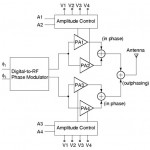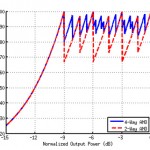Asymmetric Multilevel Outphasing for mm-Wave Transmitters
With the continued communications systems trend towards high data rates come increasingly high signal bandwidths. If the carrier frequency is not increased along with the bandwidth, then the resulting system requires a highly wideband transmitter. With a carrier frequency at mm-wave frequencies, however, a signal bandwidth of e.g. 2GHz becomes a relatively small fractional bandwidth.
Our objective is to develop a transmitter that not only is linear and efficient but that operates at high powers at mm-wave frequencies. By building on the Asymmetric Multilevel Outphasing (AMO)architecture presented in [1], we intend to employ mm-wave and architectural techniques to achieve a data rate of 2GSymbols/second. With our particular focus on high average efficiency, combined with the difficulty of designing mm-wave PAs that are themselves efficient, we have modified the AMO architecture to improve its theoretical average efficiency.
AMO works as a hybrid of polar and outphasing transmitters. The signal to be transmitted is decomposed into two outphased signals, as in the LINC architecture [2] [3], but with discretely and independently varying amplitudes. Figure 1 shows a block diagram of the proposed architecture. At high carrier frequencies it becomes increasingly difficult to produce high output powers with a single power amplifier; thus it is necessary to use multiple parallel power amplifier cells whose outputs are combined. We take advantage of the multiple cells by grouping them in an advantageous way. As shown, the cells are grouped into four PA blocks, each with independently driven amplitude. The additional amplitude paths on average result in reduced loss from outphasing as compared to the 2-way AMO system in [1]. Figure 2 shows the drain efficiency improvement of the proposed 4-way AMO when the individual PAs are assumed to be ideal.
- Figure 1: AMO architecture adapted for mm-wave transmitter.
- Figure 2: Drain efficiency improvement of proposed architecture over 2-way AMO transmitter.
References
- S. Chung, P. A. Godoy, T. W. Barton, Z. Li, T. W. Huang, D. J. Perreault, J. L. Dawson, “Asymmetric multilevel outphasing architecture for multi-standard transmitters,” in Proc. of IEEE Symposium on Radio Frequency Integrated Circuits, Boston, MA, June, 2009. [↩] [↩]
- D. Cox, “Linear amplification with nonlinear components,” IEEE Transactions on Communications, vol. 12, pp. 1942-1945, Dec. 1974. [↩]
- Y.-J. Chen, K.-Y. Jheng, A.-Y. Wu, H.-W. Tsao, and B. Tzeng, “Multilevel LINC system design for wireless transmitters,” in Proc. International Symposium on VLSI Design, Automation, and Test, 2007, pp. 25-27. [↩]

